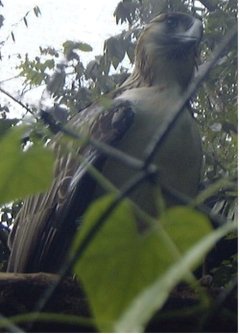Philippine Eagle
|
|
| Philippine Eagle Conservation status: Critical | ||||||||||||||
|---|---|---|---|---|---|---|---|---|---|---|---|---|---|---|
 | ||||||||||||||
| Scientific classification | ||||||||||||||
| ||||||||||||||
| Binomial name | ||||||||||||||
| Pithecophaga jefferyi Ogilvie-Grant, 1896 |
The Philippine Eagle (Pithecophaga jefferyi) is one of the most powerful birds in the world. This bird of prey belongs to the family Accipitridae.
It is sometimes called the Monkey-eating Eagle, but this name is also applied to the African Crowned Hawk-eagle and the South American Harpy Eagle.
Originally the Philippine Eagle inhabited rainforests of four major Philippine islands. Now it is restricted to the islands of Luzon and Mindanao, but it is nearly extinct on the former.
This eagle's head is adorned with long brown feathers that give it the appearance of a lion's mane. The upperside of the Philippine Eagle is brown, the underside white. This bird is 100 cm in length, up to 6 kg in weight, and has a wingspan of 220 cm.
This eagle is the world's tallest eagle, and has the largest surface area in its wings among all the species of eagles.
Philippine Eagles live hidden in the forest. They never leave this habitat and do not fly above the tree-tops. For this reason the eagle was not discovered before 1896, and the first nest was found in 1963. They feed mainly on large mammals, e.g. colugos, civets and monkeys. Sometimes they also prey on large birds like hornbills or crows.
Like most other eagles the Philippine Eagle is monogamous. The couple remains together for a lifetime. The nest is built in a tree, about 30 m above the ground. The female lays one egg. The parents will care for the egg and the young for twenty months, so they may breed only every second year.
Charles Lindbergh, best known for crossing the Atlantic in 1927, was fascinated by this eagle. As a representative of the World Wildlife Fund (WWF) he travelled to the Philippines several times between 1969 and 1972, where he helped persuade the government to protect the eagle.
PhilippineEagleDavao99.jpg
A plan was discussed to make the Philippine Eagle the heraldic animal of the Philippines; this was not translated into action, but the discussion increased awareness of the bird.
The protection plan includes the conservation of the islands' rain forests, the foundation of new national parks, and informing the local population. In 2002 there were 200 pairs of Philippine Eagles living on Mindanao, while they are almost extinct on Luzon. Political tensions on Mindanao hinder the ongoing protection of this eagle. The eagle used to inhabit 6 islands in the country, even the largest island, Luzon. Now, the eagle may only be found in Mindanao.
The eagle is slowly dwindling in numbers over the decades. Soon, the Philippine Eagle may no longer be found in the wild, unless any direct intervention be done by the government. Reintroduction of the eagle in Luzon Island and other islands have not materialised due to political conflicts. Extensive illegal logging done by cheating businessmen in league with corrupt political officials prevent a genuine effort in protecting the Philippine Eagle.da:Abeørn nl:Filipijnse apenarend sv:Filippinsk apörn
